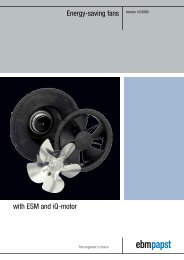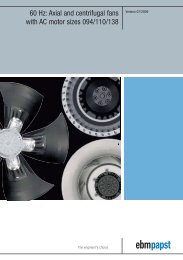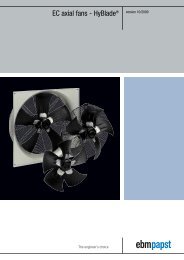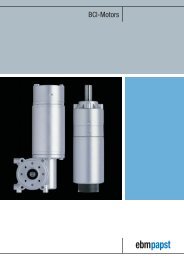Compact fans for AC and DC [PDF] - ebm-papst
Compact fans for AC and DC [PDF] - ebm-papst
Compact fans for AC and DC [PDF] - ebm-papst
- No tags were found...
You also want an ePaper? Increase the reach of your titles
YUMPU automatically turns print PDFs into web optimized ePapers that Google loves.
Fan installationIn<strong>for</strong>mation on installationWhen a fan is operated <strong>for</strong> the first time in an application, the user mayhave noticed that the flow rate in the device was lower than expected.What is the reason <strong>for</strong> this?• The values stated in this catalogue were determined under optimum,constant <strong>and</strong> comparable measurement conditions.BaffleMultidirectional intake,laminar currentsUnidirectional exhaust,turbulent• Ideal mounting conditions under which free air intake <strong>and</strong> exhaustare present are seldom feasible in practice. Quite frequently the <strong>fans</strong>must be mounted in close proximity to other components or cabinetpanels. As a consequence, the intake <strong>and</strong> exhaust currents may berestricted, causing the air flow to diminish <strong>and</strong> the noise level toincrease. Fans are particularly sensitive to obstructions which arepositioned directly in front of the output cross section as they oftencause an increase in tonal noise.Our advice: The distance between the fan <strong>and</strong> adjacent componentsshould be at least equal to the installation depth of the fan.Intake or exhaust side installationUnder ideal conditions, the operating point isrepresented as the intersection between thefan <strong>and</strong> loss curves, regardless of whether thefan is positioned at the air intake or exhaustside of the device. In addition to ensuring therequired flow rate, several additional aspectsmust be considered <strong>for</strong> determining an appropriatefan concept.The intake air currents of a fan are mainlylaminar, comprising nearly the entire suctionarea. By contrast, the exhaust air of a fan isgenerally turbulent, while it flows on a preferreddirection, e.g. axial <strong>for</strong> an axial fan. Theturbulences of the exhaust intensify the heattransfer from components within the air currents,so that mounting the fan at the airintake side of the device is recommended <strong>for</strong>cooling <strong>and</strong> heating. Mounting the fan at thedevice intake is also advantageous becausethe fan will not be subjected to the dissipatedheat of the device. There<strong>for</strong>e, it operates atlow ambient temperatures <strong>and</strong> has a higherlife expectancy.Accident preventionThe turning rotor <strong>and</strong> the high speeds thatare sometimes involved mean that our fanproducts carry an inherent risk of injury.They may only be operated after correctinstallation <strong>and</strong> with suitable protectivefacilities (e.g. with a guard grille). Morein<strong>for</strong>mation can be found in the internet at:www.<strong>ebm</strong><strong>papst</strong>.com/safety14


![Compact fans for AC and DC [PDF] - ebm-papst](https://img.yumpu.com/48610592/14/500x640/compact-fans-for-ac-and-dc-pdf-ebm-papst.jpg)


![Download [PDF] 9.8 MB - ebm-papst Automotive & Drives](https://img.yumpu.com/47171334/1/184x260/download-pdf-98-mb-ebm-papst-automotive-drives.jpg?quality=85)

![Download [PDF] 3.1 MB - ebm-papst UK](https://img.yumpu.com/40847594/1/185x260/download-pdf-31-mb-ebm-papst-uk.jpg?quality=85)

![Download [PDF] 2.1 MB - ebm-papst UK](https://img.yumpu.com/36174834/1/190x247/download-pdf-21-mb-ebm-papst-uk.jpg?quality=85)
![Download [PDF] 2.3 MB - ebm-papst UK](https://img.yumpu.com/35271378/1/190x252/download-pdf-23-mb-ebm-papst-uk.jpg?quality=85)
![Download [PDF] - ebm-papst UK](https://img.yumpu.com/35139755/1/190x135/download-pdf-ebm-papst-uk.jpg?quality=85)

![Download [PDF] 1.5 MB - ebm-papst UK](https://img.yumpu.com/30021941/1/184x260/download-pdf-15-mb-ebm-papst-uk.jpg?quality=85)
![DC fans - specials [PDF] 1.2 MB](https://img.yumpu.com/28121898/1/184x260/dc-fans-specials-pdf-12-mb.jpg?quality=85)
